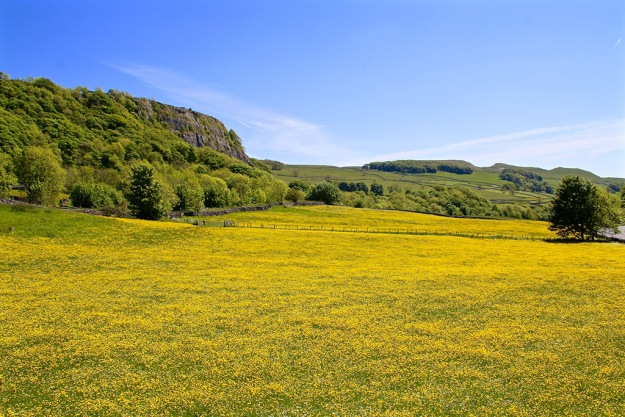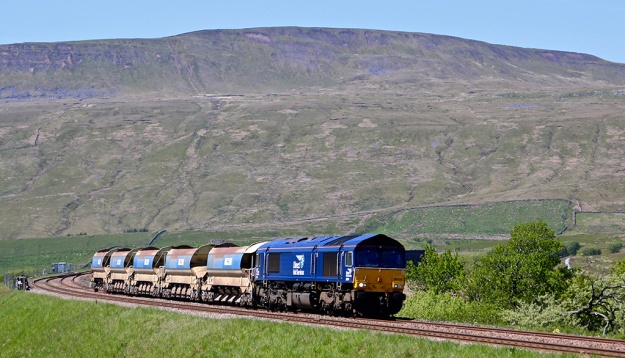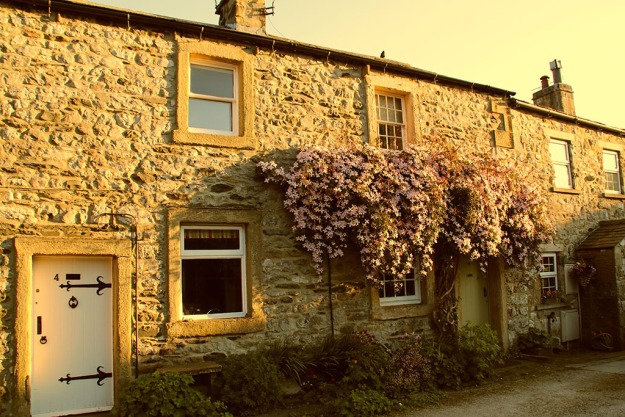 Are there more ruins in the Yorkshire Dales than ever before? Are the traditional stone barns, walls and farm buildings which make the Dales unique gradually disappearing from our precious landscape? Who should be responsible for the upkeep of these iconic Dales features? Will their demise eventually affect tourism and thus local businesses and accommodation providers? Does anyone really care? Those thoughts crossed my mind this week during a short walk on which I came across several run-down buildings. Back home I looked through photos I’d taken over the last 12 months and counted more than 20 shots which included different Dales buildings that had seen better days. I’d not gone out specifically to capture the ruins, nor was my intention to put landowners to shame. I’d merely used the buildings as foregrounds or focal points for the pictures. Some of the buildings were once beautiful structures, architecturally perfect for their settings. They used locally sourced materials and were built by local craftsmen. Agricultural progress and changes have meant that in many cases the original uses for the buildings no longer exist. Many farmers can’t afford to maintain little-used buildings. The National Park’s rigid planning rules allow little by way of development in many cases. And anyway, some are in such out-of-the-way places that changing the use and improvement to modern living standards would be beyond the reach of all but the very richest people. I don’t know what the answer is. But I do know that if nothing is done to stop our heritage from crumbling, the Dales of the future will be far less attractive for residents and visitors. There follows a selection of local Dales buildings captured by me over the last year. I should also say by way of balance that I have seen a few superbly renovated barns on my travels around the dales.
Are there more ruins in the Yorkshire Dales than ever before? Are the traditional stone barns, walls and farm buildings which make the Dales unique gradually disappearing from our precious landscape? Who should be responsible for the upkeep of these iconic Dales features? Will their demise eventually affect tourism and thus local businesses and accommodation providers? Does anyone really care? Those thoughts crossed my mind this week during a short walk on which I came across several run-down buildings. Back home I looked through photos I’d taken over the last 12 months and counted more than 20 shots which included different Dales buildings that had seen better days. I’d not gone out specifically to capture the ruins, nor was my intention to put landowners to shame. I’d merely used the buildings as foregrounds or focal points for the pictures. Some of the buildings were once beautiful structures, architecturally perfect for their settings. They used locally sourced materials and were built by local craftsmen. Agricultural progress and changes have meant that in many cases the original uses for the buildings no longer exist. Many farmers can’t afford to maintain little-used buildings. The National Park’s rigid planning rules allow little by way of development in many cases. And anyway, some are in such out-of-the-way places that changing the use and improvement to modern living standards would be beyond the reach of all but the very richest people. I don’t know what the answer is. But I do know that if nothing is done to stop our heritage from crumbling, the Dales of the future will be far less attractive for residents and visitors. There follows a selection of local Dales buildings captured by me over the last year. I should also say by way of balance that I have seen a few superbly renovated barns on my travels around the dales.
Tag: barns
Yorkshire walls of fame
Looking through the Yorkshire photos in my archive I shouldn’t have been surprised over how many shots feature walls and barns. Foregrounds, backgrounds or the main focus of attention, the skill of the stonemason is often on show. Perhaps there’s something in my genetic make-up – for in among my family history of weavers and farmers is also a long line of stonemasons. But I reckon the reason so many pictures include walls and barns is not down to genes or the volume in the area. It’s down to the fact that they look good: photogenic works of art. A perfect subject for that book I’m going to write or that exhibition I’m going to put on but both of which I’ll never get round to.
As mentioned in previous blogs, over my years of tramping the Yorkshire Dales I’ve seen an increasing number of barns being left to decay. I’ve noticed a lot more recently that are missing their stone-slate roofs. The slates are probably the most vital part of the barn – both from a protection point of view and that of value. Traditional slates are sold for large sums. Barns are being robbed of the slates by thieves, or sold by the buildings’ owners, or deliberately removed by farmers and stored elsewhere. I’m surprised it’s being allowed to happen, especially in the Yorkshire Dales National Park, as these crumbling buildings make the place look unloved and uncared for.
The Yorkshire weather’s been playing good cop/bad cop this week. Pea-sized hailstones clattered the car (pic below), and a wild lightning fork struck a nearby field as I drove down the Slaidburn road towards Clapham on Sunday. I’d been up to Bowland Knotts where I witnessed shafts of sunlight shining over Stocks Reservoir and blue sky over the distant South Pennines. The grouse moors all around changed colour like a kaleidescope, while snow remained visible in the crevices of Ingleborough and Penyghent.
Gorse is a feature in this neck of the woods and the bright yellow provided a lovely foreground for the view from a minor road towards both Ingleborough and Penyghent.

Thursday was one of the ‘good-cop’ days. Ribblehead was packed with sightseers and walkers. I headed further up to capture the view around Arten Gill – there’s never a train around when you want one to bring some action into a shot. Plenty of roofless barns to be seen, however, in these parts (see also third pic in blog).
Earlier, these sheep at Helwith Bridge mistook me for the farmer and headed towards me expecting to be fed. Yet another derelict barn here.
I stopped off for an hour’s wander around Selside and down to the river. There are some terrific old buildings in the settlement as well as great views up and down Ribblesdale and of the Three Peaks. Grade II listed Top Farm has a dated door lintel stating 1725 but parts of the building are even earlier. The postbox on the old shop bearing the former Settle-Carlisle railway station sign is an early Victorian-style box.
Around 60,000 walkers tackle the Yorkshire Three Peaks every year whether it be to raise funds for charity or just to say they’ve done the trail. The footfall has taken a toll on the iconic dales mountains, especially on the Swine Tail, the final climb before reaching the summit of Ingleborough from the north. Attempts have been made to fix the path but increased use and wetter winters mean that the best way of solving the problem is to lay stone slabs. It’s a costly business so the Mend Our Mountains campaign has started a crowd-funding appeal. Please help if you can – more details here: http://www.crowdfunder.co.uk/campaign/mend-our-mountains
Twilight added a yellow glow to my stroll around Winskill. Picture shows the outlines of Smearsett Scar and Ingleborough – oh, and a wall.
Vibrant heart of the Yorkshire Dales
Settle is one of the most vibrant places in the Dales. The brilliant Settle Stories Festival has been on this weekend and later this month the cycling tour of Yorkshire heads this way. There’s much more happening throughout the summer so if you are a visitor or resident please take a look at the 2016 guide to the area – out now with a downloadable or screen version available free from here:
https://issuu.com/2015welcometosettleguide/docs/vibrant_settle_2016_completed.compr?e=15917722/34455846
A blog about those two bright days in the Dales
(Bear with me during this lengthy blog – the sun’s gone in now and I’m reminiscing for my own amusement about the week just gone)
Two fine days in a row last week – or, what we in these parts call summer – saw me out and about with the camera once again. The pastures beneath Stainforth Scar shone like gold lamé carpets. They brought out the poet in me and I penned the following verse – but re-reading it now I wish the poet had stayed inside and had another glass of something strong.
Choose me! Choose me!
Plead the buttercups to a bee.
Come by! Come by!
Hears the languid butterfly.
Hopeful hosts of gold —
Such a sight to behold.


Further up the dale, Dry Beck Farm, which I must have photographed a hundred times, lured me in once more. I made a mental note to put together some kind of time-lapse sequence showing the shot through the seasons … one of those jobs I’ll probably never get round to. There’s a splendid beech tree in one of the fields – its fresh foliage looked vibrant against the meadows, limestone walls and bright blue sky.


Horton was busy with Three-Peakers – must be the time of year for charity fundraisers. Even fans of my footie team, Huddersfield Town, had groups out on the fells raising cash to help deprived youngsters in the Kirklees Community. I thought of those walking the 24 gruelling miles to raise a few pounds to help the under privileged while their idols were idling away their time on a beach somewhere earning up to £??k a week.
I stopped near Selside, close to the spot – a notorious bend on a hill – where a motorcyclist had sadly died after crashing into a road sign just a few days earlier. Last year a few hundred yards away, I came across another accident where a biker was killed. Dales roads weren’t meant for thrill seekers. I mentioned this on Facebook where locals added words of sadness for those involved, their own grief at witnessing and encountering these scenes, and also their annoyance at not being able to get home because of the road closure.

I’m not sure what the collective noun for train photographers is (an Orak, perhaps?) but when I saw a gathering at Ribblehead I presumed something important must be imminent. Here it is. Anyway, nice view of Whernside. I took in the exhibition at Ribblehead station while I was there – I’d been before but failed to notice the stained glass windows on previous visits. There are several depicting old railway names and emblems plus this one which lines up nicely with Ingleborough.


I motored on through Widdale which seems to be rapidly losing its clothes. the pine and spruce forests planted during the last century are gradually all being replaced by the kind of tree species that once thrived here before Man brought his hatchet into the dale.
Hawes was waking up when I travelled through on Thursday, even the ice cream sales had not begun but the parking chaos had; delivery trucks haphazardly abandoned amongst dirty farm Landrovers and unwary tourists looking for a free spot. The first bus full of grey-haired visitors was attempting to barge its way through to Wensleydale Creamery.
My mission was to try get a decent picture of the Buttertubs. The pass was quiet apart from the sheep who despite having hundreds of square miles of perfectly good moorland to wander over, prefer to meander aimlessly down the middle of the road. The mums appear unkempt at the moment with their fleeces falling apart at the seams. Their ’teenage’ lambs stay a few paces behind looking embarrassed and thinking ‘Is she really going out looking like that? I hope I don’t see any of my friends’.
I was lucky to grab one of the few parking spots at the Buttertubs which were dark and cool and had only a minor fall of water echoing in its depths. I always fear for the road’s foundations here as it spans the chasms but perhaps it’s best not to ponder too long and instead head down into Swaledale. I’ll have to try again at Buttertubs as the pics didn’t turn out too well.

Muker was thrang as Throp’s wife; I was passing through to capture the hay meadows and barns. Mainly comprising buttercups and daisies at this time of year the pastures were nevertheless a beautiful sight which I never tire of seeing. Made a mental note to come back shortly for a greater variety of plants.


Parking near Low Row, I headed for the river on the Crackpot road where I once again gazed enviously at a lovely row of cottages which overlook the Swale and the smart bridge. There’s a delightful path (partially blocked at present due to work by Yorkshire Water) which runs beside the river. The path actually goes along the top of a wall for a 100 yards or so. I felt as though I needed one of those vehicles ahead of me warning oncoming traffic of a ‘wide load’. I’d no need to worry as I didn’t see another soul for the next hour. There’s a nature trail here; flora and fauna abound, there were rabbits, too, and I heard all kinds of birds accompanied by the sound a low, brown river cackling over rocks and mini falls.


There was a small market in Reeth and every parking spot with a mile radius seemed to be taken, even on the village greens. It’s a pleasant village but I needed a bit more solitude today and headed for one of the glorious passes between Swaledale and Wensleydale.
 Don’t ask me to pick a favourite road between the two dales because they are all spectacular. On Friday I took the one from Grinton over to Redmire. The lonely isolated grouse moors are certainly not where I’d choose to be on a winter’s night but this day a wonderful place to get out of the car and sit, look and listen to the cries of curlew and lapwing cries and the wind rushing through the heather which was still brown but showing signs of budding in sheltered area.
Don’t ask me to pick a favourite road between the two dales because they are all spectacular. On Friday I took the one from Grinton over to Redmire. The lonely isolated grouse moors are certainly not where I’d choose to be on a winter’s night but this day a wonderful place to get out of the car and sit, look and listen to the cries of curlew and lapwing cries and the wind rushing through the heather which was still brown but showing signs of budding in sheltered area.
The previous day I’d taken on the pass between Askrigg and Muker/Gunnerside where I came face to face with a car on a 1 in 4, 45 degree bend. The other driver looked terrified so I reversed blindly, praying there was nothing following. Last year I took the Satron road – more of a track really but it is surfaced – which runs parallel to, and joins on to, this one. It’s not signposted and feels like a private road to a farm but it is a public way (I think!). It’s scary and you require a gate-opening passenger and someone to mop your brow. The views of Wensleydale dropping into Askrigg are vast and I was lucky to capture a glimpse of Semerwater across the wide valley.

Heading back to Ribblesdale I was tempted to park up for a walk to Snaizeholme and see if the red squirrels would come out to pose for me but it was getting late. When I returned home my neighbour’s clematis was basking in the late evening light … sadly, I’ve not seen much of the sun since.




























